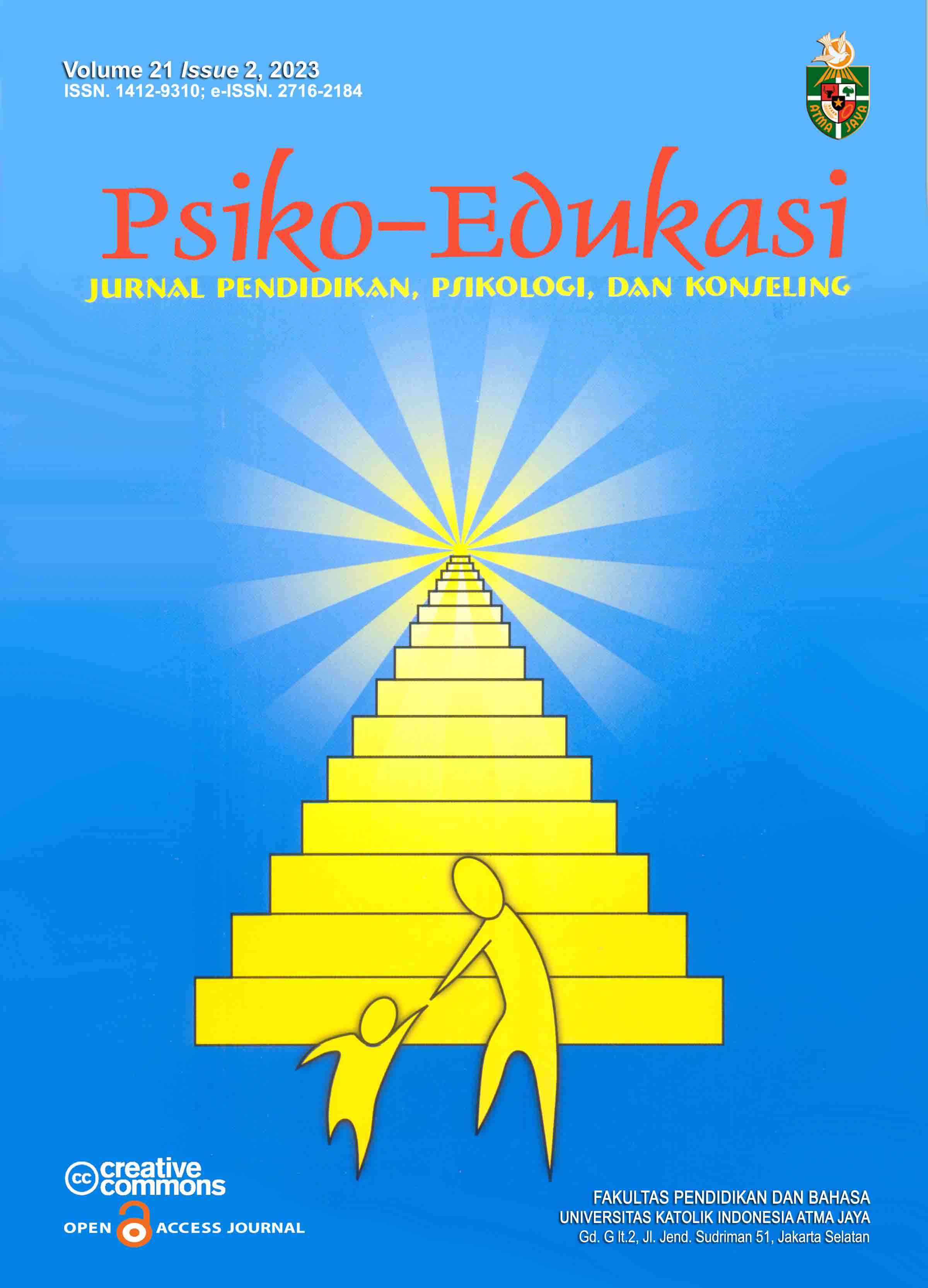Fifty Years of British Journal of Guidance and Counselling: A Bibliometric Analysis
DOI:
https://doi.org/10.25170/psikoedukasi.v21i2.4944Kata Kunci:
British Journal of Guidance and Counselling, Analisis BibliometrikAbstrak
This article presents a bibliometric analysis of fifty years of the "British Journal of Guidance Counselling," the leading journal in the field. It provides insights into various aspects of guidance and counselling, including education, supervision, crisis intervention, career counselling, and multicultural approaches. The study examined different types of publications and their role in advancing scientific knowledge. Scientific articles were the most frequently cited and essential to disseminating knowledge. On the other hand, documents such as errata and letters were considered supplementary information rather than primary reference sources. The analysis also includes descriptive and network analysis, which consists of the number of publications per year, most prolific authors, and institutions.
Referensi
Amirbagheri, K., Núñez-Carballosa, A., Guitart-Tarrés, L., & Merigó, J. M. (2019). Research on green supply chain: a bibliometric analysis. Clean Technologies and Environmental Policy, 21(1), 3–22. https://doi.org/10.1007/s10098-018-1624-1
Barrio Minton, C. A., Wachter Morris, C. A., & Yaites, L. D. (2014). Pedagogy in counselor education: A 10-year content analysis of journals. Counselor Education and Supervision, 53(3), 162–177. https://doi.org/10.1002/j.1556-6978.2014.00055.x
Cohn, D., & Hofmann, T. (2001). The missing link - A probabilistic model of document content and hypertext connectivity. Advances in Neural Information Processing Systems.
Cox, A. M., & Pinfield, S. (2014). Research data management and libraries: Current activities and future priorities. Journal of Librarianship and Information Science, 46(4), 299–316. https://doi.org/10.1177/0961000613492542
Davis, D. E., Bowes, S., McLaughlin, A., Hsu, W., Gazaway, S., McElroy-Heltzel, S., Van Tongeren, D. R., & Hook, J. N. (2023). In search of convergent creativity: content analysis of research on intellectual humility. Journal of Positive Psychology, 18(2), 304–315. https://doi.org/10.1080/17439760.2022.2154706
Frey, B. S., & Rost, K. (2010). Do rankings reflect research quality? Journal of Applied Economics, 13(1), 1–38. https://doi.org/10.1016/S1514-0326(10)60002-5
Gaskó, N., Lung, R. I., & Suciu, M. A. (2016). A new network model for the study of scientific collaborations: Romanian computer science and mathematics co-authorship networks. Scientometrics, 108(2), 613–632. https://doi.org/10.1007/s11192-016-1968-4
Goyal, K., & Kumar, S. (2021). Financial literacy: A systematic review and bibliometric analysis. International Journal of Consumer Studies, 45(1), 80–105. https://doi.org/10.1111/ijcs.12605
Hou, Q., Mao, G., Zhao, L., Du, H., & Zuo, J. (2015). Mapping the scientific research on life cycle assessment: a bibliometric analysis. International Journal of Life Cycle Assessment, 20(4), 541–555. https://doi.org/10.1007/s11367-015-0846-2
Kassen, M. (2018). Adopting and managing open data: Stakeholder perspectives, challenges and policy recommendations. Aslib Journal of Information Management, 70(5), 518–537. https://doi.org/10.1108/AJIM-11-2017-0250
Konstantina Vasileiou, Julie Barnett, Susan Thorpe, & Terry Young. (2018). Characterising and justifying sample size sufficiency in interview-based studies: systematic analysis of qualitative health research over a 15-year period. BMC Medical Research Methodology, 18(1), 1–18.
Lozano, S., Calzada-Infante, L., Adenso-Díaz, B., & García, S. (2019). Complex network analysis of keywords co-occurrence in the recent efficiency analysis literature. Scientometrics, 120(2), 609–629. https://doi.org/10.1007/s11192-019-03132-w
Mahi, M., Ismail, I., Phoong, S. W., & Isa, C. R. (2021). Mapping trends and knowledge structure of energy efficiency research: what we know and where we are going. Environmental Science and Pollution Research, 28(27), 35327–35345. https://doi.org/10.1007/s11356-021-14367-7
Mann, K., Gordon, J., & MacLeod, A. (2009). Reflection and reflective practice in health professions education: A systematic review. Advances in Health Sciences Education, 14(4), 595–621. https://doi.org/10.1007/s10459-007-9090-2
Martínez-López, F. J., Merigó, J. M., Valenzuela-Fernández, L., & Nicolás, C. (2018). Fifty years of the European Journal of Marketing: a bibliometric analysis. European Journal of Marketing, 52(1–2), 439–468. https://doi.org/10.1108/EJM-11-2017-0853
McMahon, M. (2014). New Trends in Theory Development in Career Psychology. 13–27. https://doi.org/10.1007/978-1-4614-9460-7_2
Merigó, J. M., & Yang, J. B. (2017). A bibliometric analysis of operations research and management science. Omega (United Kingdom), 73, 37–48. https://doi.org/10.1016/j.omega.2016.12.004
O’Leary, P., Tsui, M. S., & Ruch, G. (2013). The boundaries of the social work relationship revisited: Towards a connected, inclusive and dynamic conceptualisation. British Journal of Social Work, 43(1), 135–153. https://doi.org/10.1093/bjsw/bcr181
Ocaña-Fernández, Y., Valenzuela-Fernández, L. A., & Garro-Aburto, L. L. (2019). Artificial Intelligence and its Implications in Higher Education. Purposes and Representations, 7(2), 536–552.
Pan, X., & Hamilton, A. F. d. C. (2018). Why and how to use virtual reality to study human social interaction: The challenges of exploring a new research landscape. British Journal of Psychology, 109(3), 395–417. https://doi.org/10.1111/bjop.12290
Paphawasit, B., & Wudhikarn, R. (2022). Investigating Patterns of Research Collaboration and Citations in Science and Technology: A Case of Chiang Mai University. Administrative Sciences, 12(2). https://doi.org/10.3390/admsci12020071
Romero-Silva, R., & de Leeuw, S. (2021). Learning from the past to shape the future: A comprehensive text mining analysis of OR/MS reviews. Omega (United Kingdom), 100, 102388. https://doi.org/10.1016/j.omega.2020.102388
Susetyarini, E., & Fauzi, A. (2020). Trend of critical thinking skill researches in biology education journals across Indonesia: From research design to data analysis. International Journal of Instruction, 13(1), 535–550. https://doi.org/10.29333/iji.2020.13135a
Taras, V., Rowney, J., & Steel, P. (2009). Half a century of measuring culture: Review of approaches, challenges, and limitations based on the analysis of 121 instruments for quantifying culture. Journal of International Management, 15(4), 357–373. https://doi.org/10.1016/j.intman.2008.08.005
Yarime, M., Trencher, G., Mino, T., Scholz, R. W., Olsson, L., Ness, B., Frantzeskaki, N., & Rotmans, J. (2012). Establishing sustainability science in higher education institutions: Towards an integration of academic development, institutionalization, and stakeholder collaborations. Sustainability Science, 7(SUPPL. 1), 101–113. https://doi.org/10.1007/s11625-012-0157-5
Zhao, L., Yang, M. M., Wang, Z., & Michelson, G. (2023). Trends in the Dynamic Evolution of Corporate Social Responsibility and Leadership: A Literature Review and Bibliometric Analysis. Journal of Business Ethics, 182(1), 135–157. https://doi.org/10.1007/s10551-022-05035-y
Zuffianò, A., Alessandri, G., Gerbino, M., Luengo Kanacri, B. P., Di Giunta, L., Milioni, M., & Caprara, G. V. (2013). Academic achievement: The unique contribution of self-efficacy beliefs in self-regulated learning beyond intelligence, personality traits, and self-esteem. Learning and Individual Differences, 23(1), 158–162. https://doi.org/10.1016/j.lindif.2012.07.010
Unduhan
Diterbitkan
Versi
- 2023-12-01 (3)
- 2023-12-01 (2)
- 2023-10-31 (1)

















